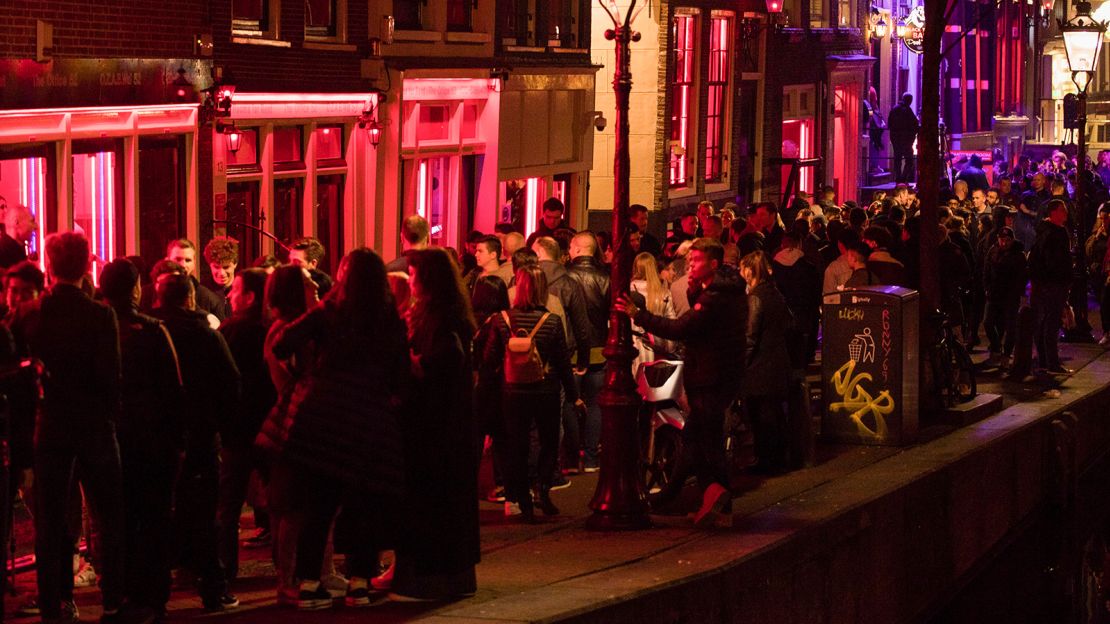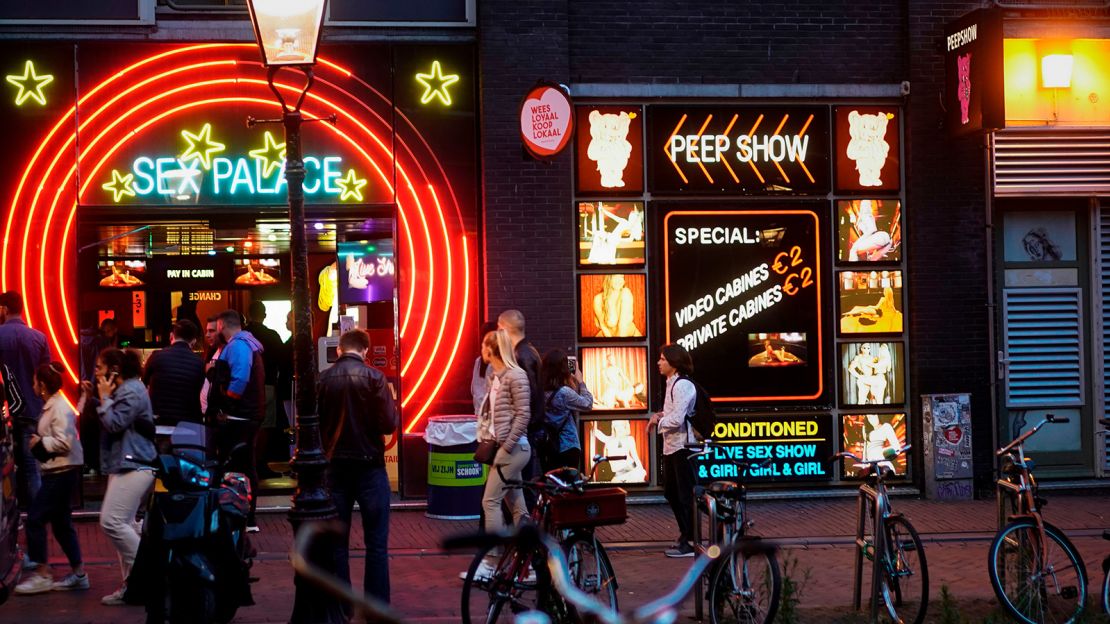Editor’s Note: Sign up for Unlocking the World, CNN Travel’s weekly newsletter. Get news about destinations opening, inspiration for future adventures, plus the latest in aviation, food and drink, where to stay and other travel developments.
It’s barely dusk on a cold Saturday afternoon in early December. But Amsterdam’s Red Light District is already starting to heat up.
Bursts of spirited cheers ring out from crowded bars during World Cup soccer matches. Whiffs of marijuana waft from coffee shops. Hordes of tourists shuffle along the narrow streets, making it difficult – if not impossible – for a car or even a bike to pass through.
A few men stop to ask lingerie-clad sex workers posing behind brothel windows about their services. But the vast majority simply stare or gawk as they stroll.
At one establishment along the Oudezijds Voorburgwal canal, a middle-aged man wearing jeans and a baseball cap snaps a photo of his friend against the window, despite signs forbidding photography. They trade places for another photo, then walk off, laughing.
It’s just another day in one of the world’s most infamous tourist hubs. But if city officials have their way, the De Wallen neighborhood, as it’s known locally, will eventually draw visitors who come to appreciate its unique heritage, architecture and culture instead of its vices.
In the latest initiative of an ongoing bid to boost Amsterdam’s image, reduce rowdy behavior from visitors and improve livability and safety for residents, city officials recently announced policy proposals “to limit tourism growth and nuisance” and combat overcrowding.
This latest round of proposed measures includes initiatives targeting troublesome tourist behavior, such as limiting the number of river cruises; implementing earlier closing times for bars, clubs and window brothels; and banning cannabis smoking in certain parts of the city.
Another part of the initiative focuses on “actively discouraging international visitors with plans to ‘go wild’ in Amsterdam,” which has been dubbed as the “stay away” campaign.
“Some businesses misuse Amsterdam’s image to sell it as a place of ‘unlimited possibilities,’” Deputy Mayor Sofyan Mbarki said in a statement. “As a result, some groups of visitors think of it as a city where anything goes. This kind of tourism, as well as offerings specifically targeting these groups, is not considered desirable by the Municipal Executive.”
The policy proposals, which were announced on November 30 and are part of a broader initiative to address mass tourism, must pass a vote by city council on December 21 before they are enacted. But some in Amsterdam’s tourism sector are already on board.
“We should get rid of the image of sex, drugs and rock and roll,” says Remco Groenhuijzen, general manager of the M?venpick Hotel Amsterdam City Center. “It’s not bad that we have a city that’s a little bit on the edge. But that’s not a free [pass] to come here and misbehave.”
‘The right balance’

Groenhuijzen says the majority of the members of the Luxury Hotels of Amsterdam, an association of 24 four- and five-star hotels of which he serves as chairman, generally approve of the city’s bid to polish up its reputation through various measures that attempt to address (and prevent) the unsavory consequences of tourists behaving badly.
“As hoteliers, we think a city should be livable, because that’s when it’s nice to come here,” Groenhuijzen says. “That was always the strength of Amsterdam, to have the right balance.”
But in recent years, especially as post-pandemic tourism has come roaring back, overtourism has tipped that balance alarmingly out of whack – especially in highly visited neighborhoods like De Wallen.
In 2023, Amsterdam is predicted to exceed 18 million overnight visitors. By 2025, that number could reach 23 million, in addition to another 24 to 25 million day visits. When the number of overnight visitors reaches 18 million, the city council is “obliged to intervene” based on a 2021 ordinance called “Amsterdam Tourism in Balance.”
During an interview in the cheerful downtown offices of Amsterdam & Partners, the city’s public-private marketing nonprofit, director Geerte Udo estimates that about 10 to 15% of Amsterdam’s tourist industry is located in the Red Light District. But combine the disruptive tourists with an overcrowding problem, and on weekends “it’s really, really unlivable in the old city center during these days,” Udo says, noting that certain streets are particularly problematic.
Udo described the city’s tourism reboot as a multi-layered approach with specific campaigns designed to target unique groups of visitors, while rebranding Amsterdam as a destination whose draws go far beyond brothels and cannabis cafes – along with making the city safer and more livable for residents and more enticing for visitors.
One specific measure, for example, would target day visitors, many of whom drive in from around the Netherlands, as well as from neighboring countries including Germany, and sleep in their cars instead of staying in a hotel.
When discussing the plans, Udo often avoids using the term “Red Light District.” “It’s now become sort of a theme park name for a neighborhood,” she explains. “And if we … want to change the perception, you should not keep talking about the Red Light District if you prefer the red lights to go out.”
Erotic center still on hold

Those infamous lights are, for now, still shining. But, in perhaps the most controversial aspect of the city’s tourism reboot, they may dim in the coming year depending on the status of a proposed “erotic center” that would move the window brothels into a single building located on the outskirts of town.
The project was originally envisioned as an “erotic hotel” by Amsterdam Mayor Femke Halsema, who in 2018 became the first female mayor of the Dutch capital.
It has gained approval from some groups, including various political parties, and been sharply criticized by others, most notably, sex workers.
They claim that taking away the visibility of the windows makes their work less safe, and that placing the center in a remote area of the city, far from well-known tourist areas, would harm their business.
Jeroen de Jong, chief operating officer of Amsterdam Red Light District Tours, whose app offers self-guided tours through the district (in-person tours were banned at the start of 2020), predicted that the erotic center “will fail and become a financial catastrophe.”
De Jong also noted that there are a couple more areas around Amsterdam with window brothels. “Sex workers already have the choice to work in different places in the capital,” he said via email.
It’s anybody’s guess when the 15,000-square-foot, multi-story center, which has a commissioned architect on board, will officially open. Following fierce opposition to the first eight proposed sites, the city has delayed the decision and may expand the list to include additional sites, Dutch newspaper Het Parool reported.
Nonetheless, Halsema remains determined. “I hope it’s possible to create an erotic center that has some class and distinction and isn’t a place where only petty criminals, the most vulnerable women gather, but also people who are not ashamed to go there,” she told the media outlet DutchNews.NL this fall.
‘Leave it be’

The future of the Red Light District may be unclear, but for now, business is humming along as usual. And for many of the workers and customers who frequent adult novelty shops, cannabis cafes, porn shows and other enterprises in the neighborhood, that’s the way it should be.
“[Government] just wants to regress everything, move it away, get all these fancy houses back to rich people,” says Linda Nap, an employee of a sex accessories shop in De Wallen, in between a steady stream of customers.
According to de Jong, instead of spending money on anti-tourism campaigns, the city would be much better served by increasing its police presence in the Red Light District – a common request among residents and entrepreneurs in the neighborhood. “A frequently heard complaint … is: ‘We don’t want more rules, but more enforcers and police,’” he says.
Nap, who says many of her customers are sex workers, says the city’s continued measures will strip the neighborhood of its unique spirit, which, like the profession it has built itself around, has been thriving for centuries. And while she understands residents’ frustrations about overcrowding and noise, she contends that the realities about living in the neighborhood have always been highly visible.
“[The sex industry] has been here since the 1600s – people don’t come here only for the canals and tulips,” Nap says. “Leave it be. If you have a problem, then move somewhere else.”
(Top image: Amsterdam’s De Wallen neighborhood. Sylvain Sonnet/The Image Bank Unreleased/Getty Images)
Blane Bachelor is a Florida-born, Amsterdam-based journalist who covers travel, aviation, and outdoor adventure.
